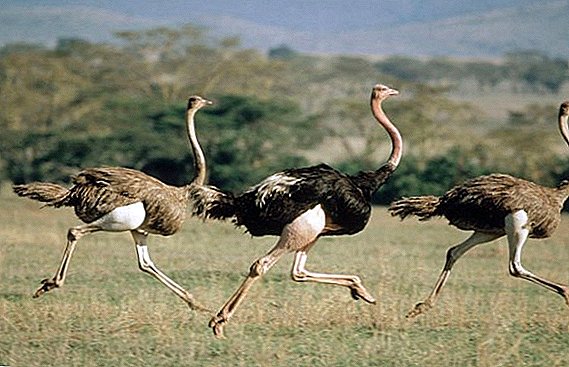 In the bird world, ostriches are the only heavyweight owners of long muscular legs and poorly developed two-meter wings. They never rise to the sky and flee from threatening predators. What is the maximum speed can develop these non-flying birds, learn further from the article.
In the bird world, ostriches are the only heavyweight owners of long muscular legs and poorly developed two-meter wings. They never rise to the sky and flee from threatening predators. What is the maximum speed can develop these non-flying birds, learn further from the article.
What determines the speed
Due to its strong and thick legs, ostriches can overcome great distances in a short time. Their limbs are characterized by well-developed muscles, providing speed of movement, and a pair of fingers on each paw.  If you look at the bird’s foot in detail, you can see that there is no nail on the short inconspicuous process. And on the second finger there is a powerful claw.
If you look at the bird’s foot in detail, you can see that there is no nail on the short inconspicuous process. And on the second finger there is a powerful claw.
Did you know? The legs of ostriches are a killing weapon. For comparison: a horse's hoof kick is estimated at 20 kg per square centimeter, and an ostrich's kick is 30 kg! Such a force easily bends an iron bar of 1.5 centimeter thickness and smashes human bones..
For the ostrich, it is very important because:
- regulates the speed of the feathered while running and walking;
- is a support when the bird defends itself while defending itself;
- helps to push off in a step and maneuver on the run without reducing speed.
Modern ornithologists, taxonomists and evolutionists believe that all ostrich-like animals have one ancestor that existed along with dinosaurs during the Mesozoic period. It is the now extinct bird from the order of lithorates, which lived about 55 million years ago.
Find out whether it is possible to breed ostriches at home. And also find out where the ostrich and the American ostrich live and what they eat.
Her petrified remains were found in Europe and North America. Consequently, ostriches originally possessed the ability to fly. In this way they spread to all continents of the globe. This theory was confirmed by genetic research.  However, flying giant birds required a large run-up for take-off, which was convenient for attacking predators. That is why winged heavyweights preferred flight, rather than flight.
However, flying giant birds required a large run-up for take-off, which was convenient for attacking predators. That is why winged heavyweights preferred flight, rather than flight.
Did you know? In their natural habitat, ostriches consider hyenas and jackals to be their worst enemies, who are ruining bird nests. Only chicks suffer from lions, tigers and other felines, as they cannot overcome adults..
As a result, each new generation of giant birds began to develop strong muscular legs, and their wings ceased to fulfill their original purpose. Thus, the front limbs for the bird became only a minor tool in adjusting the speed, since the main load was distributed to the legs.
Ostrich run is characterized by smoothness and tranquility. These giants can travel hundreds of kilometers, using their energy resources efficiently. In one step, they move 4 meters forward.
Due to well developed muscular tissue on the legs, their movements are springy, light and graceful. And when the bird accelerates, it seems that it just moves faster with its legs, because its body does not bend, as is typical of any runner. 
What speed does an ostrich develop when running
In extreme circumstances, ostriches can run at speeds of up to 70 kilometers per hour, which not every four-legged mammal can do. For comparison: sprint athletes during running competitions overcome only 30 kilometers in the same period of time.
Did you know? In the wild, ostriches are characterized by an enviable survival rate. From the majority of the chases they come out victorious, because, fleeing from predators, these giants, with the help of wings, can dramatically change the direction of the run without reducing their speed. After such maneuvers of a potential victim, the exhausted predator needs time to resume the chase.
Let's take a closer look at how quickly these non-flying giants are able to walk and run.
Average
In a calm environment, the feathered creature paces at a speed of 20-30 kilometers per hour, and when running, it accelerates to 50 kilometers. According to experts, this is possible due to the unique physiological characteristics of the hind and fore limbs of a giant bird.
Important! A farmer who deals with ostriches should always be alert. After all, feathered, though they remember their survivor well, they react very aggressively to sudden movements. That is why many breeders try to protect themselves from unforeseen aggression of birds by primitive bogeymen, which are tied to themselves. The main thing is that the height of this structure exceeds the height of the birds. Then, guided by the principle “who is taller, that is more important,” the pet will respectfully react even to the raised hand of the owner.
In the last decade, zoologists have paid much attention to the structure of the musculoskeletal system of ostriches. Their main task is the disclosure of the ostrich phenomenon in comparison with the human body. It is believed that in this way, scientists will be able to discover additional potential for runner athletes. 
In case of danger
When a predator begins to hunt in the wild savanna for an ostrich, the bird runs away at a speed of 70-75 km / hour. This means that with every second it overcomes about 20 meters. It is characteristic that on the run the length of the ostrich step increases to 7 m.
You will also be interested to know how it is useful and how to cook an ostrich egg and how to use ostrich fat.
Researchers claim that these birds are not particularly fearful. Per kilometer they can notice the potential danger and get away from it in time. In addition, ostriches, despite the possibilities of their strength, do not like to attack the aggressors, therefore, fleeing from the threat, they prefer to run faster.
Max speed
The world recorded a record when a frightened feathery heavyweight was running at a speed of 92 km / h. At the same time its energy potential was enough for a long distance.  Nature has deprived ostriches of the opportunity to soar in the sky, compensating for this flaw by strong legs. Today, these birds are no longer harnessed to wagons as a force for the force, but are bred solely for meat, eggs, and down.
Nature has deprived ostriches of the opportunity to soar in the sky, compensating for this flaw by strong legs. Today, these birds are no longer harnessed to wagons as a force for the force, but are bred solely for meat, eggs, and down.
Important! In captivity, ostriches give good indicators of productivity, subject to their year-round content in a uniform climate..Therefore, running abilities of birds do not affect their productivity in any way. Their phenomenon is of interest only in curious breeders.












